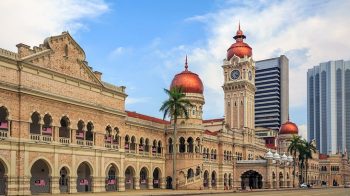Granada Spain Travel
Granada Spain: Granada is blessed with Moorish heritage dating back more than 700 years. The pinnacle of this is the Alhambra, a compound with palaces, courtyards, and gardens where the Emirs of Granada would escape the summer heat.
Drawn by the allure of the Alhambra, many visitors head to Granada unsure what to expect. What they find is a gritty, compelling city where serene Islamic architecture and Arab-flavoured street life go hand in hand with monumental churches, old-school tapas bars, and counterculture graffiti art.

You can work your way along the streets of the old Moorish city, laid out exactly as it was in Medieval times, or enter the cave dwellings of the historic gypsy neighborhood famed for its flamenco shows. All the while the soaring peaks of the Sierra Nevada will draw your gaze in the distance to the east.
What is Granada Spain famous for?
Granada is one of the pearls of Spain, most visited by tourists from all over the world. The long-time capital of Moorish Andalusia has to offer the most important reminds of this epoch in Spanish history, with the world-famous “Alhambra” at the top of the list.
Is Granada Spain safe?
Keeping your stuff safe in the hotel and in the streets. Granada is a fairly safe city and there are hardly any worries of violent or major crime. Petty theft is a general problem if there is one. As with most cities, you should be more careful in train and bus stations and around tourist attractions.
Is Granada Spain expensive?
Well, Granada is the home of tapas, and it’s the last place in Spain where they’re free. … But even the most expensive restaurants offer a cheap beer plus tapas option. Alhambra Palace: A general admission ticket costs $16, and it’s worth it.Travel Tips! Starting at the end of 2022, a new travel authorization system called ETIAS will be in place, and anyone traveling to Spain from more than 60 countries will need to apply for this. ETIAS Spain will also require it for Israelis.
Things To Do In Granada Spain
This magnificent sight is hard to sum up with a few words: The Alhambra is a palace, castle, summer retreat, and enclosed town all in one enchanting place.
It was built during the 1200s and 1300s for the Nasrids, who ruled the Emirate of Granada in the final centuries of Muslim control in Andalucia.
After the “Reconquista” it also became the royal court of the Catholic Monarchs, Isabella I and Ferdinand II. Book well in advance and spend an enthralling day pottering about royal chambers, serene courtyards, and divine renaissance and Moorish palaces.
Hotels In Granada Spain

Built on top of Granada’s mosque at the start of the 16th century this magnificent building is Spain’s second-largest cathedral. It was erected during a transition in fashion, so the foundations are gothic even if the main structure and interior are from the renaissance. The person charged with trying to find some harmony between the styles was Diego de Siloé and his efforts won him a lot of contemporary acclaims.
To soak up the brilliance of this cathedral stands in the main chapel and lift your gaze to the stained glass windows, sculptures, and paintings on the sides. Next to the cathedral is the resting place of two of Spain’s most important rulers. The Catholic Monarchs, Isabella I and Ferdinand II are interred here and had completed the Christian re-conquest of Spain from the Moors at the end of the 1400s. Their beautiful tomb is made from alabaster and was designed by the Italian sculptor Domenico Fancelli.
The tombs of their, successors Joanna of Castile and Philip I, are also in the Royal Chapel, as well as the Catholic Monarchs’ grandson, Miguel da Paz, the Prince of Portugal who died in infancy.
East of Albayzín and in front of the Alhambra is another of Granada’s traditional neighborhoods. After the city was retaken by the Catholic Monarchs Sacromonte became the home for the city’s gypsy community. The neighborhood is on the precipitous slopes of Valparaíso amid pines and cactuses, and at some point in the 16th-century, the settlers began to hew their homes from the rock-face. As you stroll past these dwellings you’ll notice how no two cave houses are the same, as their dimensions are determined entirely by the difficult terrain. Naturally, if you want to see a true flamenco performance, these caves are the real deal.
Time In Granada Spain
Granada is located in Andalusia, the south of Spain. Most people visiting this region come through Malaga, and guess what – Granada is only 1,5 hours drive away. You can easily combine it with a trip to Costa del Sol, which would balance out a seaside vacation really well.
Okay, so Granada has a lot to offer on several fronts. First and foremost, it’s home to the majestic Alhambra palace, which I’ll get to in a minute. But it’s also a great place to unwind and relax. Since it’s located in the mountains, you get that fresh mountain air not to mention the views!
The best way to explore the best things to do in Granada is by getting a Granada card. This will allow you to enter the main attractions easily, and you can even use it for public transportation. You can’t use it for the Alhambra, though. Visiting the Alhambra requires a separate ticket booked in advance, read all about it here.
Alhambra is the one thing you cannot miss on a trip to Granada. And at the same time, it’s also reason enough to even visit the town – it’s that beautiful.
I’ve already written a separate post about how amazing Alhambra is and how to plan your trip there, so I’ll keep it short, guys. The Alhambra is an Islamic fortress from the 9th century, overlooking the snowcapped mountains and city of Granada. It has numerous ruins, gardens, rooms, and pools, with the highlight being the Nasrid Palace.
You should schedule at least four hours for a trip to Alhambra.
Alhambra Granada Spain
Granada has its usual quotient of churches, museums, etc. typical for a southern European city. However, Granada has the Alhambra which is considered by some to be one of the 10 wonders of the world. In case you don’t know, the Alhambra is a massive castle constructed over many centuries.
It consists of gardens, fortifications, and sumptuous palaces. It was the home of many of the Arab Sultans who ruled the whole province so I suppose for centuries it received the optimum in interior decoration and architecture.
If you read the Koran, it continually repeats the idea that heaven is a garden with running water. From this perspective, you could say that the Alhambra is an Arabic attempt to create heaven on earth. Nowadays, two million people visit the palaces each year and 8,500 people visit the Alhambra every day. It is therefore Spain’s most visited monument. Even the biggest philistine would be impressed.
Spain is generally very monocultural in comparison to most of the other developed countries. During the years of Franco, there was very little immigration and 95% of the population are white Catholics. For centuries Spain was host to Arabic culture and this has left many strong imprints both genetically and culturally. The “Granada nos” don’t have a particularly good reputation and they are renowned for their “mala follar” which as far as I understand means cantankerousness or bad humor. There is some truth in this, and I would say that the granadinos are less friendly and lighthearted than the average Spaniard (but that still means that they are more friendly than the English).
Granada is located just at the point where the Sierra Nevada mountains meet the fertile plain of the vega. Behind it are steep mountains and in front there is flat agricultural land. I suppose it was first inhabited and grew because it was easy to defend from behind and although it is dry in the summer there is always a supply of water coming from the mountain fuelled by melting snow, the rich soil in the Vega provided an ample food source. The altitude is 630 meters.
The Palace Alhambra In Granada
The Albaicín is the old Arabic quarter located on the hill opposite the Alhambra. It is characterized by cobblestoned streets with whitewashed houses. Despite several centuries of neglect and architectural barbarities allowed by the town council it still retains a strong Arabic feeling (the Arabic population was ethnically cleansed just over 500 years ago). There are many squares with Terrazas and places to laze about and have a bite to eat. The Albaicín is an oil painter’s paradise and almost at every turn of the head, there is an attractive view, almost always involving glimpses of the Alhambra. If you go to a shop which sells any of the typical granadino pottery (white background with strong blue shapes) you will be sure to read the oft-quoted refrain: Give him alms woman because there is nothing as bad as being blind in Granada.
The English wear bowler hats and read the Times, the Swiss make good watches, wear short leather trousers, climb mountains and yodel, Americans eat hamburgers, are not shy, drive big cars, and talk loud, the typical idea of a Spaniard is of a dark-haired fiery gypsy woman dancing flamenco with a red rose clenched between her teeth with a bit of bullfighting going on in the background. All the national stereotypes are based on something and the Sacromonte is one of the places that gave rise to the connection between Spain and Flamenco.
The gypsies arrived about 600 years ago and one of the places where they congregated was in the caves of the Sacromonte. The mixture of Arabic influence combined with the particular lifestyle and temperament of the gypsies created Flamenco.
If you read any of the tourist guides to Granada they will tell you that the Sacromonte is a tourist trap, inviting gullible tourists to see second rate Flamenco performances washed down with watered red wine. Maybe that was true a few years ago but nowadays it’s not too bad. Even Bill Clinton went to one when he came. There is no point in buying a ticket off someone in the street. Just go there yourself. You can buy a ticket in your hotel and they will pick you up in a minibus.
When I lived in the Sacromonte I regularly got swamped in the street by 60 northern European purple rinse grannies as they got out of the bus on the way to see the Flamenco. People ask me which is the best Tablao (Flamenco gypsy cave). I am not an expert nor a flamenco fan, I liked the Rocío because they dance right in front of you as they go up and down the cave. Most of the others have a stage which is less intimate. The best one nowadays is at the Museo run by Enrique Canastera.






